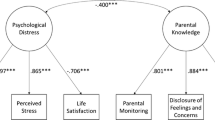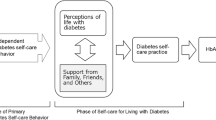Abstract
Children’s health attitudes and whether they are able to exert control over their chronic illness is related to disease management. For the current study, we assessed illness representations, general attitude toward having diabetes and health locus of control for 65 children with Type 1 Diabetes Mellitus (T1DM) and how these were related to parent report of child HbA1c levels. Results of our regression model indicated that internal locus of control moderated the relationship between illness attitude and HbA1c levels. Specifically, children with a high internal locus of control had lower (better) HbA1c levels. Additionally, children with a low internal locus of control for their diabetes and positive attitudes demonstrated lower HbA1c levels, whereas children with a low internal locus of control and negative attitudes had higher HbA1c levels. The generalizability of study findings is limited because the sample was mostly Caucasian youth reporting a fairly high locus of control. Future research is needed to determine whether changes in children’s perceptions of control over illness correspond to long-term improvements in health outcomes.

Similar content being viewed by others
Notes
Correlations among variables are available from the third author.
References
American Diabetes Association. (2002). Position statement: management of diabetes at diabetes camps. Diabetes Care, 25, S127–S129.
American Diabetes Association. (2004). Diabetes care at diabetes camps. Diabetes Care, 27(Suppl. 1), S129–S131.
Anderson, B. J., Svoren, B., & Laffel, L. (2007). Initiatives to promote effective self-care skills in children and adolescents with diabetes mellitus. Disease Management and Health Outcomes, 15, 101–108.
Austin, J. K., & Huberty, T. J. (1993). Development of the child attitude toward illness scale. Journal of Pediatric Psychology, 18, 467–480.
Baron, R. M., & Kenny, D. A. (1986). The moderator-mediator variable distinction in social psychological research: conceptual, strategic, and statistical considerations. Journal of Personality and Social Psychology, 51, 1173–1182.
Bennett-Murphy, L. M., Thomson, R. J., & Morris, M. A. (1997). Adherence behavior among adolescents with type 1 insulin-dependent diabetes mellitus: the role of cognitive appraisal processes. Journal of Pediatric Psychology, 22, 811–825.
Bush, P. J., & Iannotti, R. J. (1990). A children’s health belief model. Medical Care, 28, 69–83.
Centers for Disease Control and Prevention. (2003). National diabetes fact sheet: General information and national estimates on diabetes in the United States, 2002. Atlanta: Department of Health and Human Services, Centers for Disease Control and Prevention.
Chang, C.-W., Yeh, C.-H., Lo, F.-S., & Shih, Y.-L. (2007). Adherence behaviors in Taiwanese children and adolescents with type 1 diabetes mellitus. Journal of Clinical Nursing, 16, 207–214.
Edgar, K. A., & Skinner, T. C. (2003). Illness representations and coping as predictors of emotional well being in adolescents with type 1 diabetes. Journal of Pediatric Psychology, 28, 485–493.
Gale, C. R., Batty, G. D., Deary, I. J., & Ian, J. (2008). Locus of control at age 10 years and health outcomes and behaviors at age 30 years: the 1970 British cohort study. Psychosomatic Medicine, 70, 397–403.
Griffin, M. J., & Chen, E. (2006). Perceived control and immune and pulmonary outcomes in children with asthma. Psychosomatic Medicine, 68, 493–499.
Hamburg, B. A., & Inoff, G. E. (1982). Relationships between behavioral factors and diabetic control in children and adolescents: a camp study. Psychosomatic Medicine, 44, 321–339.
Jaccard, J., Turrisi, R., & Wan, C. K. (1990). Interaction effects in multiple regression. Newbury Park: Sage.
Kanfer, F. H. (1970). Self-regulation: Research, issues, and speculation. In C. Neuringer & J. L. Michael (Eds.), Behavioral modification in clinical psychology (pp. 178–220). New York: Appleton-Century-Crofts.
Lehmkuhl, H. D., & Nabors, L. A. (2008). Children with diabetes: satisfaction with school support, illness perceptions, and HbA1C levels. Journal of Developmental and Physical Disabilities, 20, 101–114.
O’Hea, E. L., Grothe, K. B., Bodenlos, J. S., Boudreaux, E. D., White, M. A., & Brantley, P. J. (2005). Predicting medical regimen adherence: the interactions of health locus of control beliefs. Journal of Health Psychology, 10, 705–717.
Parcel, G. S., & Meyer, M. P. (1978). Development of an instrument to measure children’s health locus of control. Health Education Monographs, 6, 149–159.
Patino, A. M., Sanchez, J., Eidson, M., & Delamater, A. M. (2005). Health beliefs and regimen adherence in minority adolescents with Type 1 Diabetes. Journal of Pediatric Psychology, 30, 503–512.
Seiffge-Krenke, I., & Stemmler, M. (2003). Coping with everyday stress and links to medical and psychosocial adaptation in diabetic adolescents. Journal of Adolescent Health, 33, 180–188.
Skinner, T. C., & Hampson, S. E. (1998). Social support and personal models of diabetes in relation to self-care and well being in adolescents with type 1 diabetes mellitus. Journal of Adolescence, 21, 703–715.
Thompson, R. J., & Gustafson, K. E. (1996). Adaptation to chronic childhood illness. Washington, DC: American Psychological Association.
Weinzimer, S. A., Doyle, E. A., & Tamborlane, W., Jr. (2005). Disease management in the young diabetic patient: glucose monitoring, coping skills, and treatment strategies. Clinical Pediatrics, 44, 393–403.
Weist, M. D., Finney, J. W., Barnard, M. U., Davis, C. D., & Ollendick, T. H. (1993). Empirical selection of psychosocial treatment targets for children and adolescents with diabetes. Journal of Pediatric Psychology, 18, 11–28.
Acknowledgements
Special thanks are extended to Dr. T. Andreone and the American Diabetes Association in Cincinnati and Stephanie Smith for their support of this project.
Author information
Authors and Affiliations
Corresponding author
Appendix
Appendix
Revised CATIS Items (Lehmkuhl and Nabors 2008):
(1) How good or bad do you feel it is to have diabetes? (2) How often do you feel that your diabetes keeps you from doing new things? (3) How often do you feel different from others because of your diabetes? (4) How often do you feel bad because of you have diabetes? (5) How often do you feel sad about having diabetes? (6) How often do you feel happy even though you have diabetes? and (7) How often do you feel just as good as other kids your age even though you have diabetes?
The questions we used from Parcel and Meyer’s scale are below (we substituted the word diabetes for the word health):
(1) Good health comes from being lucky; (2) I can do many things to fight my diabetes; (3) People who don’t have trouble managing their diabetes are just plain lucky; (4) I can make many choices about my diabetes; (5) I can do lots of things to prevent my diabetes from getting worse; and (6) Bad luck makes people’s diabetes get worse.
Rights and permissions
About this article
Cite this article
Nabors, L., McGrady, M.E. & Kichler, J. Children’s Attitudes Toward Their Diabetes, Locus of Control, and HbA1c Levels. J Dev Phys Disabil 22, 475–484 (2010). https://doi.org/10.1007/s10882-009-9183-3
Published:
Issue Date:
DOI: https://doi.org/10.1007/s10882-009-9183-3




